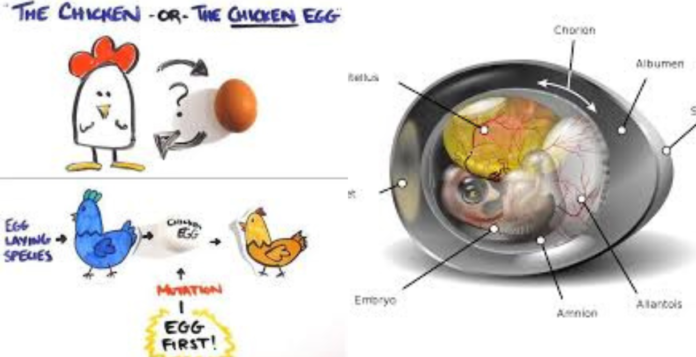There is some subtlety in the scientific response about what came first the chicken or the egg scientific answer. According to evolutionary biology, the first bird that resembled a chicken most likely originated from a non-chicken progenitor by slow genetic changes.
Therefore, a bird that wasn’t exactly a chicken lay the egg that contained the genetic material for the first chicken, and via genetic mutations, the offspring within that egg became what we now know as a chicken. Consequently, in the evolutionary cycle, the egg originated first.
Deciphering the Scientific Mysteries of “The Chicken or the Egg”
For ages, people have been perplexed by the age-old conundrum of which came first—the chicken or the egg. Despite the fact that it may seem to be a straightforward puzzle, exploring the fields of biology and evolutionary science reveals an intriguing tale of genetic adaptability and change.

Read more
family vacations in florida on a budget
can wandering jew live in water forever
what came first the chicken or the egg scientific answer
The Irregularity: Initially, it seems nonsensical: how can a chicken survive without an egg, yet how can an egg survive without a chicken to lay it? The concepts of evolution and genetics must be examined in order to provide a scientific response to this question.
Evolutionary Perspective: The explanation provided by evolutionary biology is rather convincing. It implies that the first chicken did not materialise out of thin air, but rather evolved gradually as a result of natural selection and genetic mutation. Imagine an egg being laid by a bird that is not a chicken.
Owing to chance genetic changes, the progeny inside the egg had slightly altered DNA, perhaps making it the first of what humans would eventually refer to as chickens. Therefore, the egg originated first in terms of evolution.
Genetic Mutations: Evolution is mostly driven by genetic mutations. Variations within a species are the result of gradual changes in DNA. In the case of the chicken, these mutations accumulated over time in its ancestor’s genetic code, finally giving birth to the bird we know today as the chicken.
Natural Selection: Which genetic variants survive and proliferate is largely determined by natural selection. Advantageous mutations, including improved camouflage or hunting skills, are more likely to be inherited by subsequent generations. In the case of the chicken, genetic modifications that produced traits advantageous for survival and procreation ultimately resulted in the creation of the contemporary chicken.
The debate over whether an egg or a chicken is a contradiction is really a monument to the complex processes of genetic adaptation and change that have produced life on Earth, according to evolutionary biology.
The egg predates the present chicken by being laid by a genetically altered predecessor that was not a chicken. Such inquiries serve as a reminder of the intricacy and beauty of life’s journey as we work to solve the mysteries of the natural world.
Evolutionary History: The wild jungle fowl of Southeast Asia is where the chicken’s evolutionary lineage begins. Natural selection and human selective breeding helped these birds progressively evolve over thousands of years into the domesticated chickens we know today.

Genetic variety: The foundation of evolution is genetic variety. Mutations, or variations in the DNA sequence, are the cause of it. Numerous things, including radiation, chemicals, and mistakes made during DNA replication, may result in mutations.
When it comes to the chicken, genetic changes that eventually gave birth to the contemporary chicken were caused by mutations in the DNA of the bird’s ancestors.
Speciation: The process of speciation is the origin of new species. It happens when populations of the same species separate reproductively, which causes genetic variations to gradually accumulate.
Regarding the chicken, the population underwent progressive genetic changes over many generations, eventually becoming unique enough to be recognised as a separate species.
Selective Breeding: Through selective breeding, humans have contributed significantly to the development of chickens. Humans have sped up the process of genetic change by selecting individuals with desired features for breeding, which has resulted in the creation of specialised breeds for decorative, meat, or eggs.
Fossil Evidence: The evolutionary history of chickens and their progenitors may be better understood by using fossil evidence. Scientists are able to recreate the evolutionary history with the aid of fossils of extinct bird species, which show transitional forms that span the evolutionary gap between present chickens and their non-chicken relatives.
Genetic Analysis: With the use of contemporary genetic technology like DNA sequencing, scientists are able to investigate the genetic relatedness and evolutionary links of various bird species. Researchers may determine the genetic alterations that had place throughout the evolutionary process from ancestor to descendent by comparing the DNA of chickens with those of their closest relatives.

Continued Evolution: Since evolution is a continuous process, hens are still evolving today. In chicken populations, genetic diversity and adaptability are always occurring due to environmental stresses, human practice changes, and interactions with other species.
We may better grasp the evolutionary path that separated the contemporary chicken from its prehistoric relatives by taking into account these extra factors. Hope now you know about what came first the chicken or the egg scientific answer. Please let us know if you want to know more.















